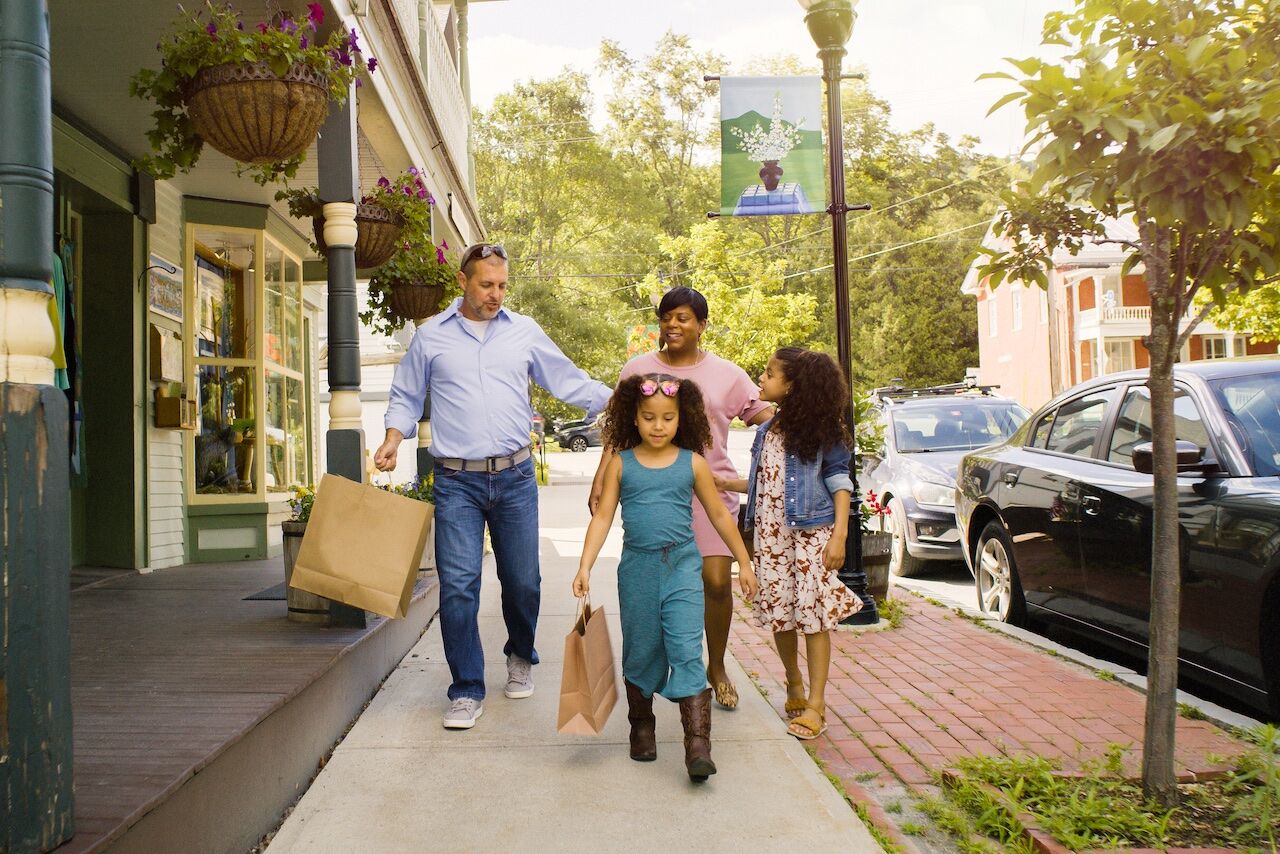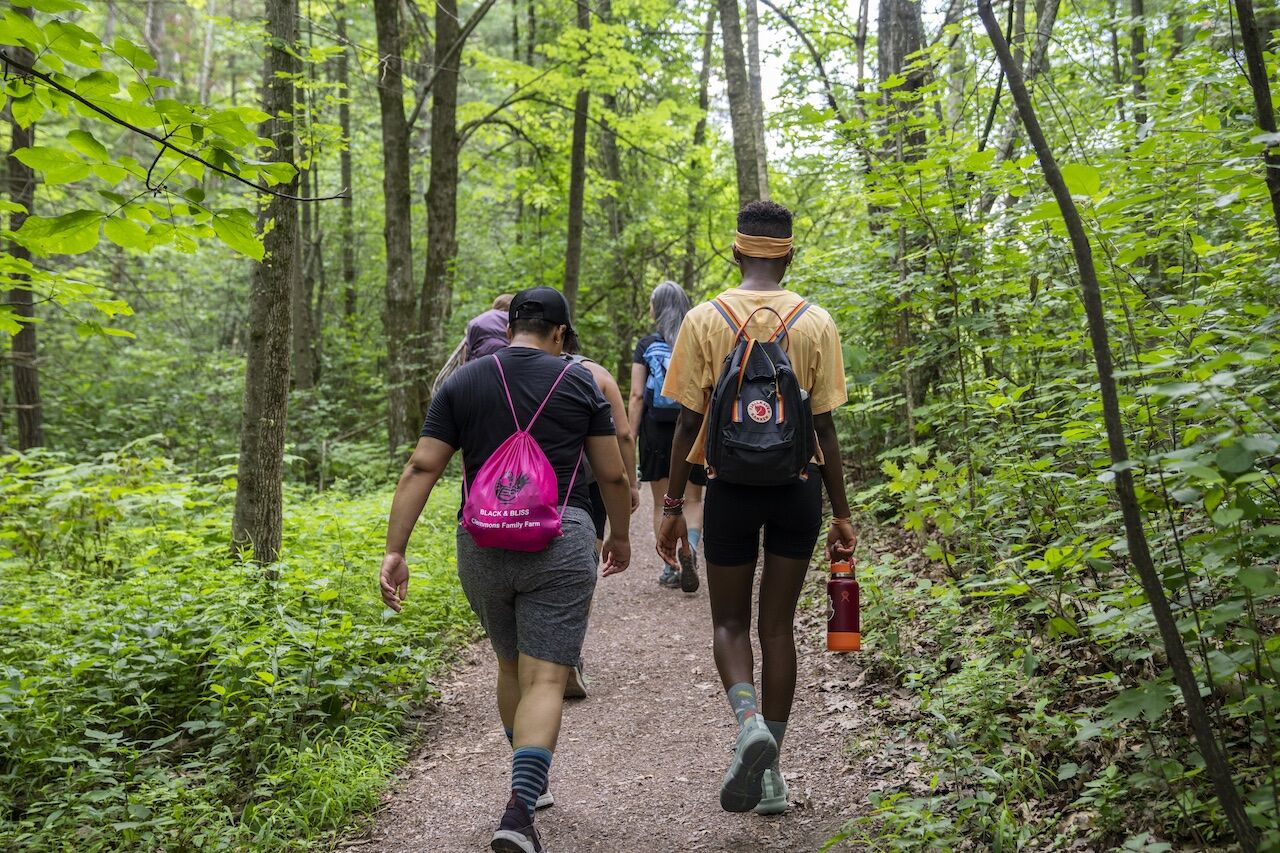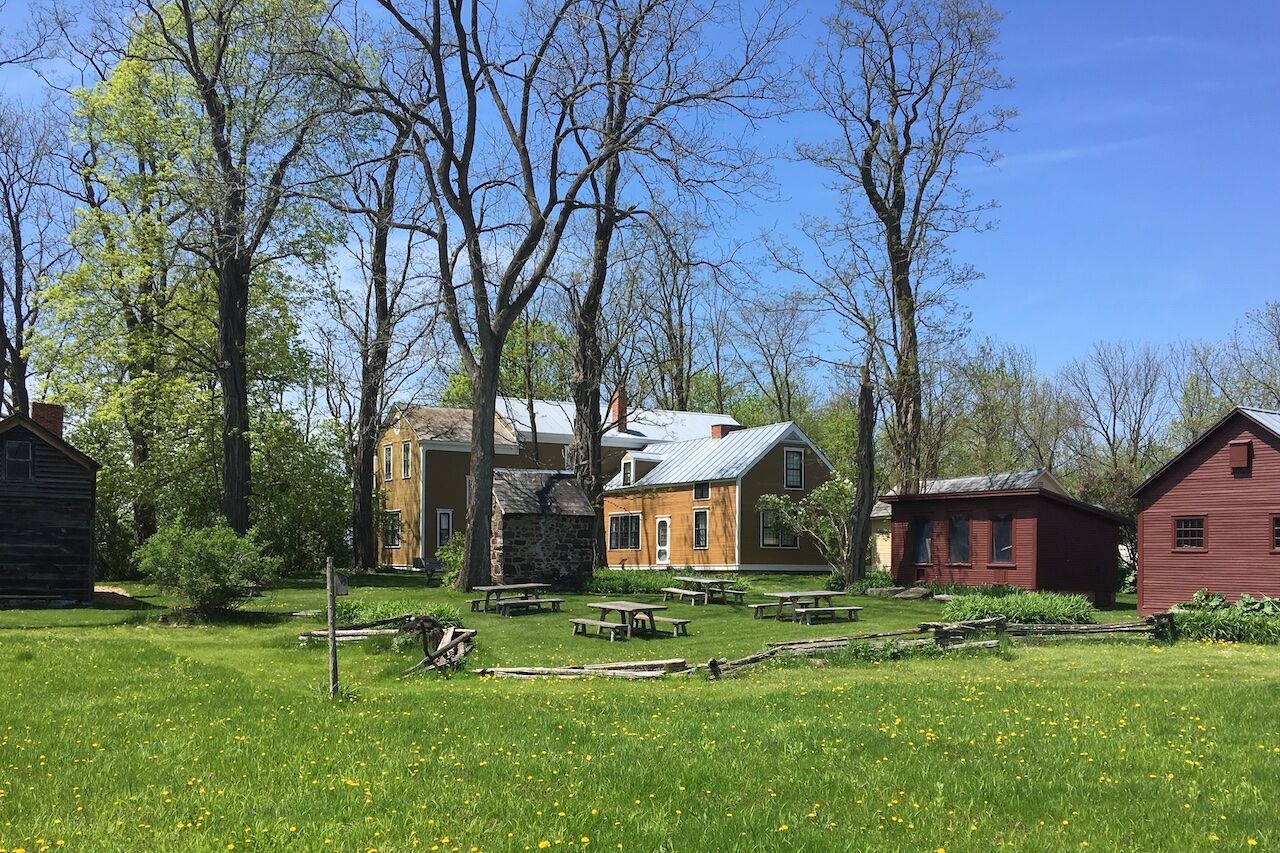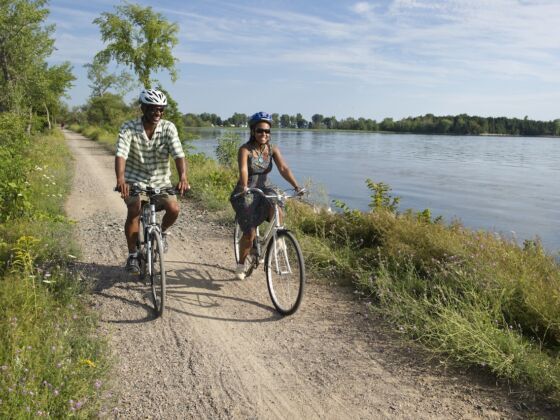As a Black traveler, what I look for in a destination is whatever makes it unique — in Vermont’s case, draws like renowned fall foliage, maple syrup, and skiing. But I also seek out places that are welcoming to travelers of color through diversity and representation. Black and other minority groups make up a small fraction of Vermont’s population, which, frankly, made me apprehensive to visit. But what I found when I made the trip was a beautiful, neighborly state filled with a host of Black-owned businesses to support along the way.
Vermont is also a year-round destination for adventure seekers, tranquil retreaters, food lovers, and multigenerational visitors. Here’s how to experience it all as a Black traveler.
Calling all “main streets”

Photo: Vermont Tourism
While it’s not always named Main Street, most towns have at least one central thoroughfare that’s brimming with boutiques, coffee shops, bookstores, galleries, and mom-and-pop eateries. Often, historic downtowns are designated areas that nod to the past even as youthful entrepreneurs bring new possibilities. Cities and towns across Vermont present some of the most charming examples of this quintessential “main street.”
A great place to start exploring Vermont is its oldest city, Bennington , which is also home to the state’s tallest statue, the Bennington Battle Monument. History buffs may enjoy a self-guided tour through the area to learn about Vermont’s role in the Revolutionary War. For a more lively scene, there’s no shortage of entertainment as the downtown area hosts live music and food festivals during the summer, bringing people of all ages together.
Spanning several blocks in downtown Burlington is the Church Street Marketplace. It has an inviting hometown feel year-round, but my mid-October visit was something special — think turning leaves, warm cider, and artisans peddling everything from cheese and desserts to crafts. On the other side of the state, St. Johnsbury is brimming with small-town hospitality. Grab a chocolate sourdough croissant from Boule Bakery to fuel your day, then head to Railroad Street and Eastern Avenue for a little thrift shopping.
Montpelier is a hub of creativity. Enjoy rave-worthy performances — from musicals to poetry slams to show tunes — at the Lost Nation Theater. After, head to Caledonia Spirits, a distillery that also crafts artful cocktails while prioritizing sustainability, from its water recovery system and composting practices to its fully carbon-free (and majority renewable) energy. Creating space for bees to thrive (a whopping 23 acres to date) is central to the Caledonia Spirits mission, not to mention its distilling ethos — just look at its Bar Hill Vodka, which is made from 100 percent premium raw and sustainably sourced honey. If ghostly spirits are more your thing, swing by Green Mount Cemetery — legend has it that Black Agnes will haunt anyone who sits in her lap.
Across the state, historic downtowns are a hallmark of Vermont. Each has its own personality and plenty to do, from antiquing, to picnicking in public parks, to ambling past beautiful brick buildings. But there’s at least one thing they all have in common: an abundance of charm.
Heading outside

Photo: Vermont Tourism
Instead of taking it all in from a car, there are many ways to get up-close and personal with Vermont’s rolling hills, mountain peaks, and glistening lakes. It may be a small state in area, but its outdoor recreation numbers are big: 55 state parks, 800 lakes and ponds, and 1,400-plus miles of mountain bike trails, to name a few.
Vermont also plays host to the longest rail trail in New England, spanning an impressive 93 miles and five different counties. Rent an e-bike from Lamoille Valley Bike Tours to pedal one or more sections of the Lamoille Valley Rail Trail to pass through beautiful downtowns and their scenic surroundings.
However you prefer to appreciate nature — hiking, biking, paddleboarding, rock climbing, even disc golf — all methods of exploring come with breathtaking views. One of my favorite outdoor spaces is Smugglers Notch State Park, a one-time illegal trading post and route used by freedom seekers moving north to Canada. There, you can enjoy trails, explore caves, and camp. More adventurous folks can try their hand at bouldering or ice climbing.
If you’re looking for opportunities to get outside, a number of affinity groups to help to immerse BIPOC residents and travelers in Vermont’s outdoor scene through hosted events, guided programs, and meetups. Seek them out as you plan your trip, or keep an eye out once you’re here.
Fun (and sweets) for the whole family

Photo: Morse Farm Maple Sugarworks
It wouldn’t be a true Vermont trip if you didn’t get your fill of maple syrup, cheese, and creemees. These local specialties also create opportunities for fun family outings, from touring farms to sampling all of the treats your little (and big) hearts desire.
To start, Vermonters take maple seriously. More than just syrup for a short stack, maple is used to make both savory and sweet treats, ranging pickles and maple-glazed chicken to donuts and creemees, a local favorite that’s similar to soft serve. See how maple is sourced at a sugar house like Montepelier’s Morse Farm Maple Sugarworks. Visits start with a video on sugar-making, and then you can walk the “maple trail” and swing by the gift shop for maple-flavored goodies (or Cabot cheese if you’re craving a savory local treat).
Speaking of sweet treats, nothing says Vermont ice cream like Ben & Jerry’s. While there are several locations, only the original factory in Waterbury hosts tours. You’ll see how the ice cream is made, taste some, and walk through the “graveyard” of retired flavors.
For families with younger children, a trip to the Billings Farm and Museum in Woodstock promises an afternoon of fun. It’s a living history museum, which means you’ll get a glimpse of what farm life was like in the late 1800s, and the kiddos will love “meeting” the farm animals. If you’re looking for an action-packed day indoors, head to the Pump House at Jay Peak, the state’s only indoor waterpark. Kids of all ages will enjoy splash zones, a surf simulator, tube lounging down the lazy river, and water slides.
Eating your way around the world

Photo: Isora Lithgow/Thingz From Yaad
Food is one of the best ways to experience a destination because it allows us to explore a culture. BIPOC chefs throughout Vermont combine local resources with recipes from their homelands to take you on unbelievable culinary journeys around the globe.
Find a taste of Jamaica in Colchester at Thingz From Yaad. Shaneall, the owner and chef, brings authentic Caribbean flavors to Vermont with classic and reimagined dishes such as curried goat, jerk chicken, ackee and saltfish, and coconut curried chickpea. In nearby Essex Junction, couple Jessica and Joel repurposed a shed to open Mexi-Cuban Cravings, dedicated to the traditional foodways of their heritages. You can find dishes like congri, bola, Cuban sandwiches, and arroz con pollo. And just two miles away, some of the best Thai food in the state is at Sukho Thai — menu favorites include dim sum, moo ping, and krapow (holy basil) duck.
At Yalla in Brattleboro, owner Zohar Arama invites passersby to delight in dishes like falafel, phool (fave bean stew), and sfenj (Moroccan donuts) that are popular in his native Israel. Yalla translates to “come on” — a common Arabic slang word that also evidences Arama’s eagerness to spread love through food.
May and Wes Stannard made history when they opened Moonwink Cafe in Manchester Center in 2018 by bringing authentic Burmese cuisine to Vermont. The restaurant’s reputation remains strong, thanks to a delicious fermented tea leaf salad and a variety of curry and noodle dishes that keep diners coming back.
Five o’clock somewhere

Photo: Vermont Tourism
Vermont hosts a variety of great Black-, minority-, and woman-owned wineries, breweries, and taprooms. Learn about the rich Vermont soil and crops that help produce award-winning beverages while tasting them firsthand.
If you find yourself near St. Johnsbury, don’t skip the small but mighty brewery and taproom at Whirligig Brewing & Bistro. No need to eat before you arrive — they have a selection of smoked meats and bar food that’s anything but typical to enjoy alongside your ale or lager. But one of the best things about Whirligig is its events, such as the Poetry Potluck Open Mic where attendees bring a dish and try their hand at sharing a poem.
Burlington is home to quite a few breweries of its own, not to mention a robust restaurant scene for a pre- or post-drink meal. Can’t decide which breweries to try? Organize a BrewHop Tour through Best in VT Tours & Charters to visit multiple drinkeries by party bus, or get to know the city first on a Burlington Trolley Tour — both companies are BIPOC-owned.
If you’re craving a glass of red or white instead, head to Wilder Wines in downtown Burlington, which offers natural and sustainable wines through local partnerships and ingredients. Kalche Wine Cooperative in Fletcher is another establishment to have on your radar. Created to improve outdated and inhumane production practices, Kalche is reclaiming what it means to be a purveyor of wine as a producer, tastemaker, and consumer.
Lessons in Black history

Historic Robinson Home. Photo: Rokeby Museum
As a Black traveler, I’m always curious to see how Black history is taught, preserved, and honored in a destination. Vermont makes it easy on the African American Heritage Trail. A statewide collection of sites and exhibits, the trail illuminates the lives of Black Vermonters, honoring their monumental contributions to the country.
One important stop is the Rokeby Museum in Ferrisburgh, where you’ll find an exhibit called Seeking Freedom: The Underground Railroad and the Legacy of an Abolitionist Family running throughout 2024. The exhibit talks about the history of enslavement in the US and Vermont, shares the journeys of freedom seekers on the Underground Railroad, and tells the story of the Robinson family, who went from enslavers to abolitionists.
If you’re traveling to Middlebury, read up on Alexander Lucius Twilight first. Graduating from Middlebury College in 1823, he was the first Black man to earn a bachelor’s degree from an American institution and Vermont’s first Black legislator. To do a deep dive on Twilight in person, his life is chronicled at the Old Stone House Museum in Brownington. Find even more cultural and historical stops using the African American Heritage Trail guide.
If the mark of a destination worth visiting is that you leave daydreaming about a return trip, Vermont certainly fits the bill. As a Black traveler, I found welcoming and progressive attitudes everywhere I went. Because of that, it’s a place I’d happily travel to again — and you should, too.

